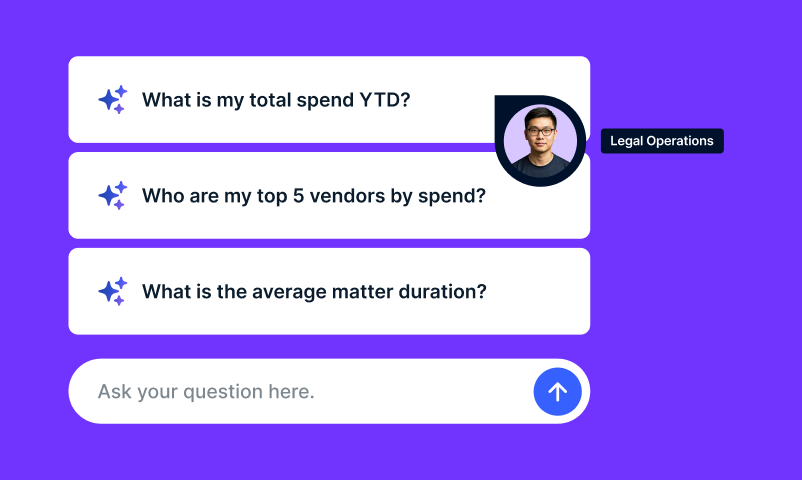
Many legal departments considering legal spend management software face a common objection internally: the organization can manage legal expenses with existing enterprise software solutions. Doing this usually involves implementing the company’s standardized purchasing processes into legal, requiring a “purchase order number” (PO Nr.). However, standard accounting procedures and software need to account for the unique features of legal procurement and legal e-billing and are no substitute for dedicated legal department software. Even generic procurement software must meet today’s responsible legal spend management requirements. In this article, we look at the reasons for this.
AP, ERP, AND PROCUREMENT SYSTEMS
Accounts Payable (“AP”) or Enterprise Resource Planning (“ERP”) systems collect and manage accounting data for a company’s suppliers. They are an integral part of the purchasing system, in which suppliers manage orders and invoices. The system automatically makes bookings in response to operational transactions and stores a booking number for each transaction. General invoice information, such as invoice issuer and recipient, amount invoiced, date, and invoice number, is entered into the system automatically.
Classic procurement systems usually contain features that enable electronic supplier selection, ordering, and tracking by the procurement department and procurement logistics. The introduction of appropriate tools aims to reduce the effort and costs per order since the ordering process is automated, and the system stores uniform supplier lists with pre-approved terms. In addition, most tools offer e-Invoicing solutions that allow suppliers to issue invoices electronically.
THE UNIQUE NATURE OF BUYING AND BILLING LEGAL SERVICES
In contrast to most other services, legal advice gets instructions from the legal department or directly from a business unit rather than the procurement department. As a result, the standard procurement processes do not apply, and regular orders do not comply with the usual corporate standards (e.g., “no order without PO number”). As a result, the unit that instructs external legal advice quickly becomes suspected of “Maverick Buying,” i.e., purchasing services outside the pre-defined procurement guidelines. In this respect, we can understand the impulse to treat legal advice in the same way as the services of other suppliers. The challenge here is that legal services are often “ordered” ad hoc, as they usually relate to urgent matters. In addition, law firms are constantly engaged on an informal basis, for example, by telephone.
The classic PO number process is unsuitable for this purpose, as it takes time and requires the specification of an order value, which is often unknown at the time of the engagement, as lawyers’ fees generally come invoiced on an hourly rate basis. The actual scope of a project only becomes apparent during the matter. Many legal departments try to follow the procurement guidelines by issuing a PO number at the beginning of the year, showing a specific budget with the definition “general legal advice.” Such a catch-all term has the opposite effect of what should come through good legal spend management: allocating invoiced costs to specific matters and activities. What may seem like an understandable and rational idea at first glance, “to engage law firms based on the standard procurement processes,” proves to be ineffective upon closer examination, as it promotes a lack of transparency and plausibility of legal costs.
In addition, invoices for legal services are usually much more complex than invoices from other suppliers. The accompanying line-item descriptions can sometimes fill walls of folders, and it is difficult to compare and check invoice amounts due to the high complexity of legal services. Progressive legal departments, therefore, use “billing guidelines” and engagement letters that define precise requirements for billable activities, expenses, and timekeepers. However, classic procurement software does not support automated checking of these legal-specific billing rules, so they ultimately come to nothing. A manual check by the staff of the in-house legal departments, be it lawyers or legal operations managers, is not economically viable. These professionals should spend time on high-value legal work, not tiresome, error-prone administrative tasks. There is a strong case for automating billing guidelines compliance through software designed for this purpose while relieving the legal department of administrative work.
ADVANTAGES OF LEGAL SPEND MANAGEMENT SOFTWARE
Clear budgeting and cost allocation
Legal spend management software ensures that all uploaded legal bills automatically get assigned to a specific matter. Legal departments can create matters themselves or have law firms create them. For example, in a complex transaction, several matter phases can be made as separate sub-matters with their budgets and different cost centers. The organization can assign different budgets if multiple law firms work on a single matter. Furthermore, the organization can assign legal project costs to individual subsidiaries within the group. These details allow for clear allocation and effective management of costs.
Automated billing guideline compliance
Legal departments can enter their billing rules into a legal spend management tool at a law firm or matter level. The system automatically checks the invoiced activities, scope of activities, and expensed amounts against the billing rules, flagging any inconsistencies or rejecting the invoice, depending on the preferred settings for that specific rule, matter and/or firm. Since the alternative to this requires error-prone and time-consuming manual review, the automated process results in significant cost savings. In addition, invoices get paid faster, and many legal departments have been able to negotiate better rates with their external legal providers based on reduced payment time.
Matter management
In addition to these fundamental features, modern legal spend management systems also record detailed matter information, such as the legal area, jurisdiction, and timekeeper seniority level, i.e., legal staff, associates, or partners. Since the data is available in a structured format, organizations can create a full report at the click of a button. Such a report can, for example, provide quarterly information on the current costs by matter, broken down according to the aforementioned matter fields. Modern legal spend management solutions can also integrate with third-party matter, document, or IP management systems. The legal spend management software is suited to act as the legal department’s leading reporting tool; it is a “single source of truth.”
Enabling data-driven legal management
The successful implementation of a legal spend management system provides the legal department with centralized and secure access to invoice data. The spend data is available at a high level of granularity, as the legal coding standards ensure the recording of sufficient information about the timekeeper and the invoiced activities. It is possible to create reports on activities, types of activity, or expenses at any time. Organizations can make data-driven decisions based on the high transparency gained regarding legal spend. This applies to short-term decisions, such as limiting the scope of research during a matter, to long-term strategies, such as insourcing re-occurring legal work and creating new in-house roles. The reporting and analytics modules are tailored to the legal department’s requirements and can configure for accounts or users. Analytics can evaluate all matters and firms on any combination of fields within the system. The reporting and analytics tools provide helpful information that legal departments can use to make data-based decisions around, for example, which firms to engage for certain types of legal work, matters, or to negotiate better hourly rates and alternative fee agreements.
Recording and communicating work in progress (WIP)
Law firms can enter un-billed activity into the legal spend management system at regular time intervals, for example, on a weekly or monthly basis. The legal department can access the current cost status of their matters at any time through the WIP functionality to keep an eye on budgets and ensure budget compliance before the costs are invoiced. This enables the legal department to forecast and budget more accurately, reducing surprises when submitting invoices. Legal departments can predict outstanding costs for financial year-end and quarter-end audits and create automated reports to communicate any outstanding fees to their financial department or auditors.
Furthermore, tracking WIP gives visibility that prevents undesirable developments; it is easy to identify and discuss out-of-scope services. Law firms tend to record their times more accurately, which is also in the client’s interest.
Sourcing and survey modules
Legal departments can use Onit’s European legal spend management solution BusyLamp eBilling.Space‘s sourcing module to obtain fee quotes quickly and easily from law firms using a standard process that enables a fair comparison among the different offers from the law firms. The competitive nature of an invitation to tender ultimately leads to more favourable prices. The legal department can use the pricing data gained through the sourcing process to improve its budgeting process.
After completing a matter, there is also the possibility of evaluating the firm’s performance. For example, the quality of the legal advice provided, if the firm met deadlines/timelines, responsiveness, and compliance with the agreed terms, especially regarding budget compliance, are evaluated. Organizations can share feedback with law firms to improve the relationship. It is also possible to request feedback from the law firms to get their perspective on the collaboration’s quality. If organizations use these functions consistently, the decision as to which law firm to engage for a particular matter or legal area comes not from a “gut feeling” but from sound data.
IMPACT ON FINANCE AND PROCUREMENT
Legal spend management software offers significant benefits that generic systems cannot provide. However, it should complement the alternative solution to AP or procurement systems. Modern legal spend management systems integrate with any open-interfaced software. Our experience shows that the best results come through combining these two solutions. This enables the legal department to operate effective legal spend management, and finance receives the relevant information promptly into the AP system. A legal spend management tool acts like a funnel that precedes the central AP system, gathering valuable legal-specific information and positively affecting the quality of essential information for procurement and finance.
Request a demo of BusyLamp eBilling.Space today.









